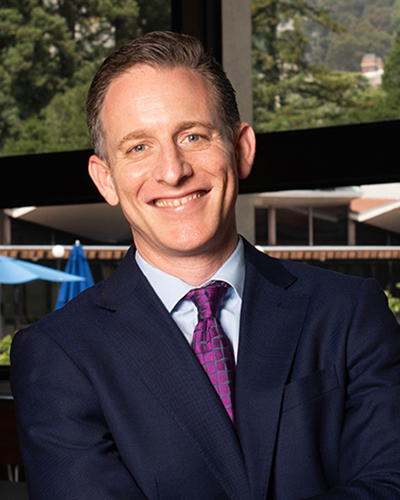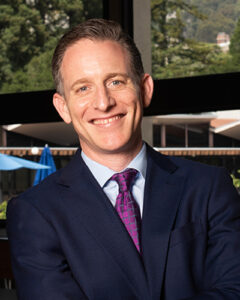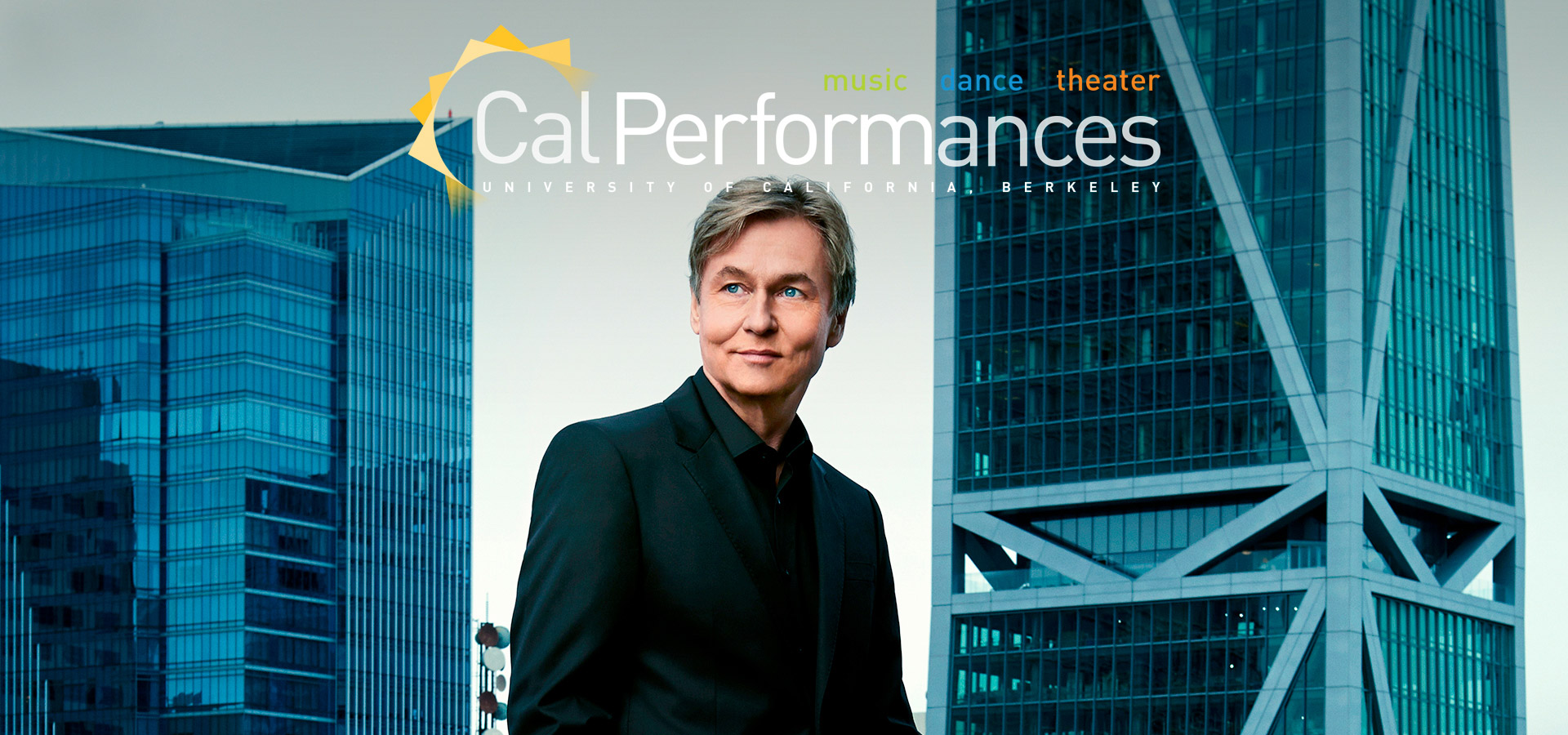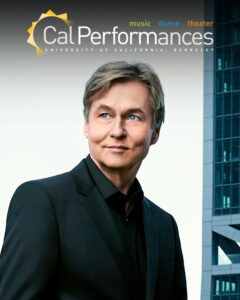San Francisco Symphony
Esa-Pekka Salonen, music director
Esa-Pekka Salonen, music director
Friday, November 10, 2023, 8pm
Zellerbach Hall
Support for the San Francisco Symphony is provided by Fred Levin, The Shenson Foundation.
From the Executive and Artistic Director

November is always a busy month at Cal Performances, and once again this season, I can’t think of a time period that so clearly displays the impressive depth and breadth of our programming. In the coming weeks alone, we’ll run the gamut of live performance, including classical-music recitals with star instrumentalists cellist Sheku Kanneh-Mason (Nov 1) and harpsichordist Jean Rondeau (Nov 5); the brilliant ensemble playing of early-music champions Le Consort (Nov 8) and the Takács Quartet (Nov 12); a return visit by the great San Francisco Symphony, performing under Music Director Esa-Pekka Salonen in a concert featuring the world premiere of a new work by Jens Ibsen and a solo turn by the orchestra’s principal clarinetist Carey Bell (Nov 10); a brilliant new program by the always popular Silkroad Ensemble under artistic director Rhiannon Giddens (Nov 17); our annual visit by The English Concert in an all-star concert performance of Handel’s Rodelina (Nov 19); cutting-edge jazz from the legendary trio of pianist Brad Mehldau (Nov 11); and highly anticipated appearances by theater/cabaret sensations John Cameron Mitchell and Amber Martin (Nov 4) and Broadway superstar Kristin Chenoweth (Nov 15).
And that’s only the start! As we continue through the season, you’ll find more than 80 carefully curated events designed to appeal to the eclectic interests and adventurous sensibilities of Bay Area audiences. In total, this year’s schedule features nearly 30 companies, ensembles, and solo artists new to our program, offering a wide range of opportunities to discover unfamiliar performers and artworks. There’s plenty to enjoy, including six world premieres, six Cal Performances co-commissions, nearly one dozen local and regional premieres, and the West Coast premieres of Taylor Mac & Matt Ray’s Bark of Millions and Nathalie Joachim’s Ki moun ou ye (Who are you?).
Cal Performances continues to invest in ongoing relationships with established and acclaimed artistic partners, with upcoming presentations including a landmark collaboration between Germany’s Pina Bausch Foundation, Senegal’s École des Sables, and the UK’s Sadler’s Wells theater in the first-ever Bay Area performances of Bausch’s pioneering The Rite of Spring (1975), as well as the renewal of a multi-season residency by The Joffrey Ballet, which this year will present its first full-length narrative ballet, Anna Karenina, at Zellerbach Hall. And I’m especially pleased that in March 2024, the renowned pianist Mitsuko Uchida will join us as Artist in Residence for two special concerts as well as additional opportunities for the campus and wider Bay Area community to engage with her singular artistry.
A focus of the season will be our multi-dimensional Illuminations programming, which once again will connect the work of world-class artists to the intellectual life and scholarship at UC Berkeley via performances and public programs investigating a pressing theme—this season, “Individual & Community.” Concepts of “individual” and “community” have been at the forefront of public discourse in recent years, with some models increasing polarization and radicalization within our society. Questions have emerged as to how we can best nurture a sense of community and how the groups we associate with impact our own sense of self. Given our fast-evolving social landscape, how can we retain and celebrate the traits that make each of us unique, while still thriving in a world that demands cooperation and collaboration? With the performing arts serving as our guide and compass, our 2023–24 “Individual & Community” programming will explore the tensions that come into play when balancing the interests of the individual with those of the group.
Please make sure to check out our website for complete information. We’re thrilled to share all the details with you, and to welcome you once again to Cal Performances!
Jeremy Geffen
Executive and Artistic Director, Cal Performances
 November is always a busy month at Cal Performances, and once again this season, I can’t think of a time period that so clearly displays the impressive depth and breadth of our programming. In the coming weeks alone, we’ll run the gamut of live performance, including classical-music recitals with star instrumentalists cellist Sheku Kanneh-Mason (Nov 1) and harpsichordist Jean Rondeau (Nov 5); the brilliant ensemble playing of early-music champions Le Consort (Nov 8) and the Takács Quartet (Nov 12); a return visit by the great San Francisco Symphony, performing under Music Director Esa-Pekka Salonen in a concert featuring the world premiere of a new work by Jens Ibsen and a solo turn by the orchestra’s principal clarinetist Carey Bell (Nov 10); a brilliant new program by the always popular Silkroad Ensemble under artistic director Rhiannon Giddens (Nov 17); our annual visit by The English Concert in an all-star concert performance of Handel’s Rodelina (Nov 19); cutting-edge jazz from the legendary trio of pianist Brad Mehldau (Nov 11); and highly anticipated appearances by theater/cabaret sensations John Cameron Mitchell and Amber Martin (Nov 4) and Broadway superstar Kristin Chenoweth (Nov 15).
November is always a busy month at Cal Performances, and once again this season, I can’t think of a time period that so clearly displays the impressive depth and breadth of our programming. In the coming weeks alone, we’ll run the gamut of live performance, including classical-music recitals with star instrumentalists cellist Sheku Kanneh-Mason (Nov 1) and harpsichordist Jean Rondeau (Nov 5); the brilliant ensemble playing of early-music champions Le Consort (Nov 8) and the Takács Quartet (Nov 12); a return visit by the great San Francisco Symphony, performing under Music Director Esa-Pekka Salonen in a concert featuring the world premiere of a new work by Jens Ibsen and a solo turn by the orchestra’s principal clarinetist Carey Bell (Nov 10); a brilliant new program by the always popular Silkroad Ensemble under artistic director Rhiannon Giddens (Nov 17); our annual visit by The English Concert in an all-star concert performance of Handel’s Rodelina (Nov 19); cutting-edge jazz from the legendary trio of pianist Brad Mehldau (Nov 11); and highly anticipated appearances by theater/cabaret sensations John Cameron Mitchell and Amber Martin (Nov 4) and Broadway superstar Kristin Chenoweth (Nov 15).
And that’s only the start! As we continue through the season, you’ll find more than 80 carefully curated events designed to appeal to the eclectic interests and adventurous sensibilities of Bay Area audiences. In total, this year’s schedule features nearly 30 companies, ensembles, and solo artists new to our program, offering a wide range of opportunities to discover unfamiliar performers and artworks. There’s plenty to enjoy, including six world premieres, six Cal Performances co-commissions, nearly one dozen local and regional premieres, and the West Coast premieres of Taylor Mac & Matt Ray’s Bark of Millions and Nathalie Joachim’s Ki moun ou ye (Who are you?).
Cal Performances continues to invest in ongoing relationships with established and acclaimed artistic partners, with upcoming presentations including a landmark collaboration between Germany’s Pina Bausch Foundation, Senegal’s École des Sables, and the UK’s Sadler’s Wells theater in the first-ever Bay Area performances of Bausch’s pioneering The Rite of Spring (1975), as well as the renewal of a multi-season residency by The Joffrey Ballet, which this year will present its first full-length narrative ballet, Anna Karenina, at Zellerbach Hall. And I’m especially pleased that in March 2024, the renowned pianist Mitsuko Uchida will join us as Artist in Residence for two special concerts as well as additional opportunities for the campus and wider Bay Area community to engage with her singular artistry.
A focus of the season will be our multi-dimensional Illuminations programming, which once again will connect the work of world-class artists to the intellectual life and scholarship at UC Berkeley via performances and public programs investigating a pressing theme—this season, “Individual & Community.” Concepts of “individual” and “community” have been at the forefront of public discourse in recent years, with some models increasing polarization and radicalization within our society. Questions have emerged as to how we can best nurture a sense of community and how the groups we associate with impact our own sense of self. Given our fast-evolving social landscape, how can we retain and celebrate the traits that make each of us unique, while still thriving in a world that demands cooperation and collaboration? With the performing arts serving as our guide and compass, our 2023–24 “Individual & Community” programming will explore the tensions that come into play when balancing the interests of the individual with those of the group.
Please make sure to check out our website for complete information. We’re thrilled to share all the details with you, and to welcome you once again to Cal Performances!
Jeremy Geffen
Executive and Artistic Director, Cal Performances
About the Performance
Esa-Pekka Salonen (b. 1958)
kínēma (2021)
First SF Symphony Performances
Instrumentation: solo clarinet and strings
Duration: About 30 minutes
Esa-Pekka Salonen was a composer long before he was a conductor, and in fact first picked up a baton in service of his composing ambitions. He studied composition and horn at the Sibelius Academy in Helsinki and formed several new-music groups with his classmates Magnus Lindberg and Kaija Saariaho. As a young composer in the late 1970s, he was a disciple of the avant-garde, writing ambitiously brainy music that intentionally froze out the heart. “If I’d even mentioned emotion in my 20s, I’d have been kicked out of the gang,” he recalled in a 2007 interview with The Guardian.
But as his conducting career took off—leading classics as much as contemporary music—he opened a more expressive side in his writing. His tenure as music director of the Los Angeles Philharmonic, beginning in 1992, was as transformative for Salonen as it was for the LA Phil. His exposure to the diverse cultures of California, as well as to American classical styles (such as the post-minimalism of John Adams), remade his music. When he stepped down from the orchestra in 2009, he reduced his conducting to focus again for a time on composing, producing a series of orchestral works including Nyx (2011), Pollux (2018), and Castor (2019). His recent works still have a certain cerebral quality and an openness to surprise and sonic invention, but seem more expressive and transporting than simply provocative. In the words of the critic Paul Griffiths, “He is, in everything he does, a composer of dream landscapes, through which we are led to encounter things at once strange and familiar, and always full of character.”
Salonen has been a composer in residence with the New York Philharmonic and most recently Berlin Philharmonic. In 2014, he won the Nemmers Composition Prize, which included a residency at Northwestern University and performances by the Chicago Symphony. In 2011 his Violin Concerto won the Grawemeyer Award, and his early Floof won the UNESCO Rostrum Prize. Today his music is performed by major orchestras across the world, led both by Salonen himself and other leading conductors. (See page 14 for Esa-Pekka Salonen’s full biography.)
Salonen’s kínēma comprises five “scenes” for solo clarinet and string orchestra. It was commissioned and premiered in 2021 by the Finnish Radio Symphony and its principal clarinetist, Christoffer Sundqvist. The title comes from the Ancient Greek word for “movement,” which gives us the word “cinema” in English. Much of the material came from Salonen’s score for the 2021 Finnish film Odotus (The Wait), a romance set on a remote Baltic island. The piece’s small forces were influenced by pandemic-era constraints, though it has a precedent in Aaron Copland’s 1949 Clarinet Concerto, which is similarly scored. Salonen described:
I thought it would be nice to write a piece that didn’t require a huge orchestra, that could be played under more intimate conditions. [At first] I decided to call it “five scenes,” because the movements are not necessarily interconnected, and also they are more like spaces, where you can exist for a few minutes. The title kínēma comes from the fact that the material is based on film scores. Most of it is very lyrical, and you might imagine a romantic film—a triangle drama, say.
There’s a lot of music that could be characterized as “beautiful,” in the old-fashioned sense of the word. On the surface it doesn’t sound “modern.” The finale has different kinds of mood, different kinds of material, and then it ties everything together and quotes the very first movement of the piece.
—Benjamin Pesetsky
Benjamin Pesetsky is Associate Director of Editorial for the San Francisco Symphony. He has also written program notes for the Philadelphia Orchestra, St. Louis Symphony, and Melbourne Symphony.
Jens Ibsen (b. 1995)
Drowned in Light (2023, World Premiere
and SF Symphony Commission)
Instrumentation: 2 flutes (2nd doubling piccolo), 2 oboes, 2 clarinets (2nd doubling bass clarinet), 2 bassoons (2nd doubling contrabassoon), 4 horns, 2 trumpets, 2 trombones, tuba, timpani, percussion (triangle, trap set, glockenspiel, vibraphone, tubular bells, and marimba), harp, piano, electric guitar, and strings
Duration: About 15 minutes
Jens Ibsen is the 2022 winner of the San Francisco Symphony and San Francisco Conservatory of Music’s Emerging Black Composers Project. A composer and a tenor, he has also been commissioned by the Oregon Bach Festival Composer Symposium, Impulse New Music Festival, Mary Pickford Foundation, and the Kennedy Center’s Cartography Project. He has sung with the Choir of Trinity Wall Street in New York, OS Ensemble, and spent two-and-a-half years as a member of the Vienna Boys Choir.
Ibsen was born in Ghana to an American father, who was in the country to study West African Drumming, and a Ghanaian mother. “I literally exist because of an interest in world music,” he said in an interview for SFCM. When he was nine months old, his family moved to the United States, where they settled in Daly City. He sang locally with Ragazzi Boys Chorus, and then auditioned for the Vienna Boys Chorus, moving to Austria after being accepted. He later earned a bachelor of arts in music composition at Pepperdine University and a master of music from the Mannes School of Music. His composition teachers include Missy Mazzoli, Randall Woolf, Matthew Brown, and Matthew Cmiel.
Jens Ibsen writes:
All artists have obsessions, and some obsessions are life-long. A few of my own have been classical-era musical forms like sonata and rondo form, modern pop-song structures, bass-driven grooves, polyrhythm, and vernacular musical styles—in short, chasing after the sweet spot of what’s catchy and complex. This piece incorporates all of these elements; it is a concise distillation of my musical philosophy and my feelings about the San Francisco Bay Area, my home.
The title of the piece and its first movement is both an allusion to one of my favorite Rolo Tomassi tracks, A Flood of Light, and also from how the music appeared to me in my mind; I have various forms of synesthesia, so the imagery associated with the themes came to me like bright, overwhelming light. Musical material often comes to me spontaneously, I do much of my writing in my head and developed most of the first movement of this piece this way. At the time I was listening to a lot of Rolo Tomassi, a UK-based band that blends shoegaze and hardcore to make music that is both sensitive and exhilarating. I knew that to channel these hardcore sounds, I needed the proper instrumentation. I’ve written several pieces for acoustic instruments imitating electric ones, but for this piece I knew I had to have the real thing. As a result, the first movement is very electric-guitar–forward, almost like a concerto. Structurally, it has a song-like form with a refrain introduced in the slow introduction that gradually is developed and expanded over the course of the piece, with various episodes foregrounding either the guitar or the ensemble. Drumming is integral to this style of music, so naturally there is a prominent drum-set part as well.
The second movement is much more sedate. The mental picture I have of the music contains deep hues of the night sky, hence the title “Nightswimming.” After being drowned in light, the listener comes up from the depths into a beautiful, azure evening. I wanted this piece to be imbued with the softer side of shoegaze and surf rock, giving it a nostalgic, yearning feeling. My many years of sunlit days and moonlit evenings growing up in the Bay have coalesced into the sounds of this work, my poem to the place I call home.
—B.P.
Igor Stravinsky (1882–1971)
Symphony in Three Movements (1942–45)
Instrumentation: 2 flutes, piccolo, 2 oboes, 3 clarinets (3rd doubling bass clarinet), 2 bassoons, contrabassoon, 4 horns, 3 trumpets, 3 trombones, tuba, timpani, bass drum, harp, piano, and strings
Duration: About 22 minutes
Except for the not-quite-one-minute Greeting Prelude for Pierre Monteux’s 80th birthday, the Symphony in Three Movements was Stravinsky’s last work for big orchestra and in the big-orchestra style. That was a style in which Stravinsky had not worked for years. At the work’s premiere, the densely packed orchestral sonority came in for a good deal of comment, as did the unbridled physical energy of the first and third movements. In the 1930s and 1940s, it was widely assumed that the old Stravinsky was dead, and the rugged sounds and exciting syncopations of the new Symphony raised hopes that the effete Parisian neoclassicist had, thank heaven, reverted to his sacrale Russian roots. (Of course the brash—and so American—final chord was much remarked upon, disapprovingly.)
In 1907, when he was still studying with Nicolai Rimsky-Korsakov, Stravinsky wrote a symphony—in part, I suppose, to be respectable, in part as an exercise of craft. That early Symphony in E-flat is an attractive piece; but from the composer of Firebird and the Requiem Canticles and two or three dozen masterpieces in between, one expects so much more. It was years before Stravinsky wrote another symphony. Symphonies of Wind Instruments (1920) suggests “symphony,” but the composer really meant “symphonies” literally as “sounding together.” The Symphony of Psalms (1930) is obviously a special case, too. So the two real Stravinsky symphonies are the Symphony in C, begun in 1938 in France and finished in 1940 in this country, and the “all-American” Symphony in Three Movements.
Tautly concentrated and quite short, the Symphony in Three Movements nonetheless feels big, like a symphony. At the same time, Stravinsky achieves a sense of symphonic breadth and pace without making development of themes in the familiar sense the mainstay of his dialectic.
The work is made of blocks set unmitigated, unmodulated, side by side; here, in fact, is a connection with Stravinsky’s past. The first movement falls into three large divisions, roughly in the proportions 2:3:1. The first of these sections is in the big-band style; the second is more chamber-musical in character; the third reverts mainly to the manner of the first, but, carrying over some elements of the second, functions as well as a synthesis of the opposing elements.
Within each section Stravinsky moves abruptly from point to point. In the first minute, the arresting opening gesture for almost the full orchestra is followed by a passage of stalking horn and trumpet calls against chugging clarinet chords, and that by a passage for strings and piano. But along with these jolts, or underneath them, Stravinsky sets things that bind, connections established by nicely placed reminders of certain harmonies or melodic contours or sonorities. Even the tempos of the tutti and concertante middle sections, though they feel very different, share a common pulse.
Stravinsky stated that this first movement was designed originally as a work with an important solo piano part. In the second movement, Stravinsky gives a prominent part to the harp, and it becomes the task of the finale to provide a piano-harp synthesis.
In his program note for the premiere of the Symphony he insisted that the work was absolute music. But in 1963, in Dialogues and a Diary, he admitted specifically the influence of movies in the first and third movements, of a documentary on scorched-earth tactics in China in the former, of newsreel footage of goose-stepping soldiers in the latter. Moreover, the last part of the finale was associated in his mind with “the rise of the Allies after the overturning of the German war machine.”
Whatever the inner and outer sources, Stravinsky gave us a work of remarkable brilliance and power. The first movement rocks with a fierce accent, pungent harmony, and sapidly clangorous sound. In the Andante, Stravinsky follows (or perhaps doesn’t) Beethoven’s frequent example of offering something more of an intermezzo or a bridge than a fully worked movement. The finale is reached, without a break, by way of a seven-measure interlude that, with an amazing economy of means, sets the scene for the harmonies and textures to come. After the transparent sonorities of the second movement—they are too hard-edged to be called delicate—Stravinsky returns to the massive tones of the first movement. One of the finale’s mini-chapters is a fugue whose jagged intervals suddenly look ahead to the Stravinsky of the late 1950s and 1960s. Stravinsky, by the way, suggests the possibility that this fugue is in some way the continuation of the one started, then “abandoned . . . like a very hot potato,” in the corresponding movement of the Symphony in C. The abundant physical thrust of the first movement returns, too, and the finale, as Stravinsky’s “program” indicates, concludes in assertive triumph.
—Michael Steinberg
Michael Steinberg, the San Francisco Symphony’s program annotator from 1979 to 1999 and a contributing writer until his death in 2009, was one of the nation’s preeminent writers on music.



